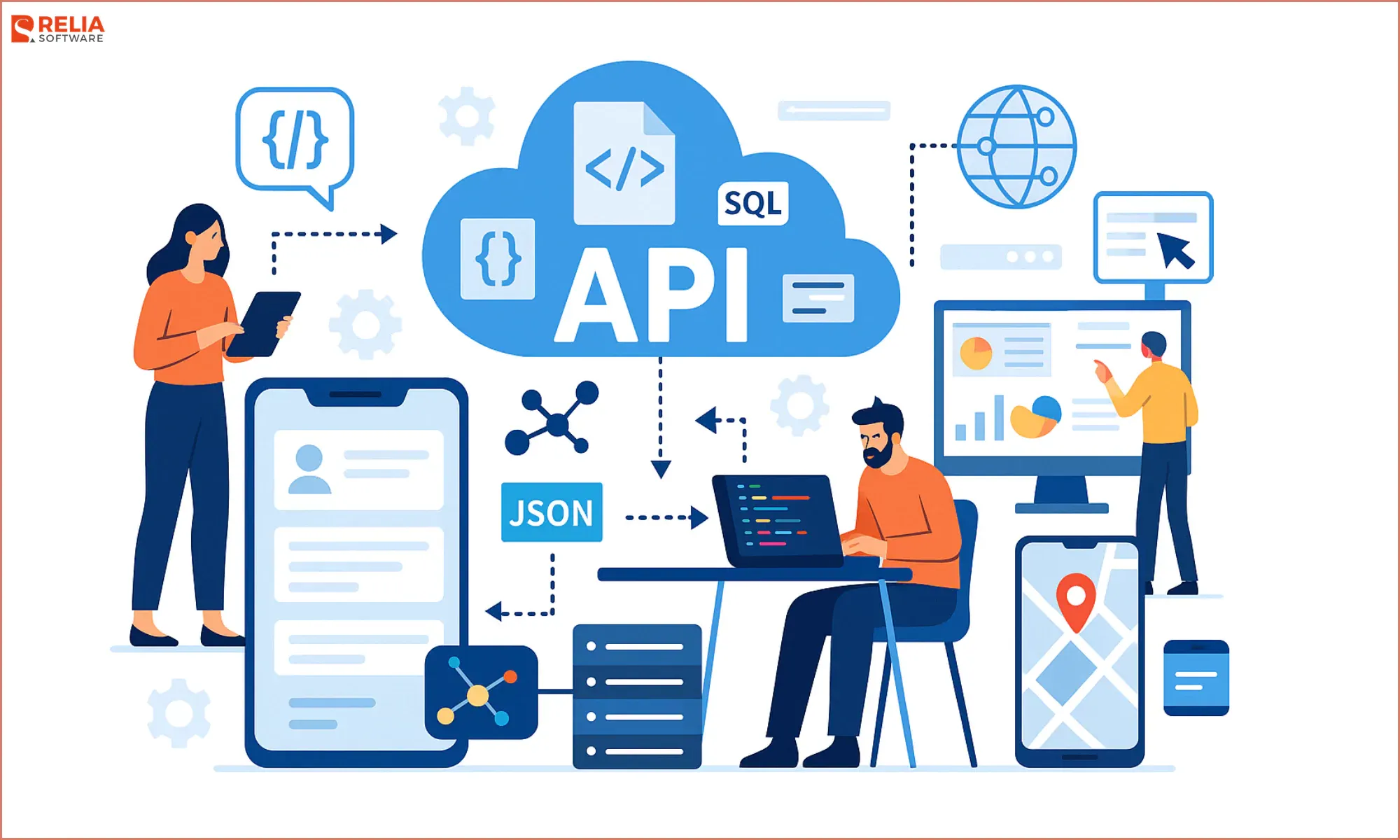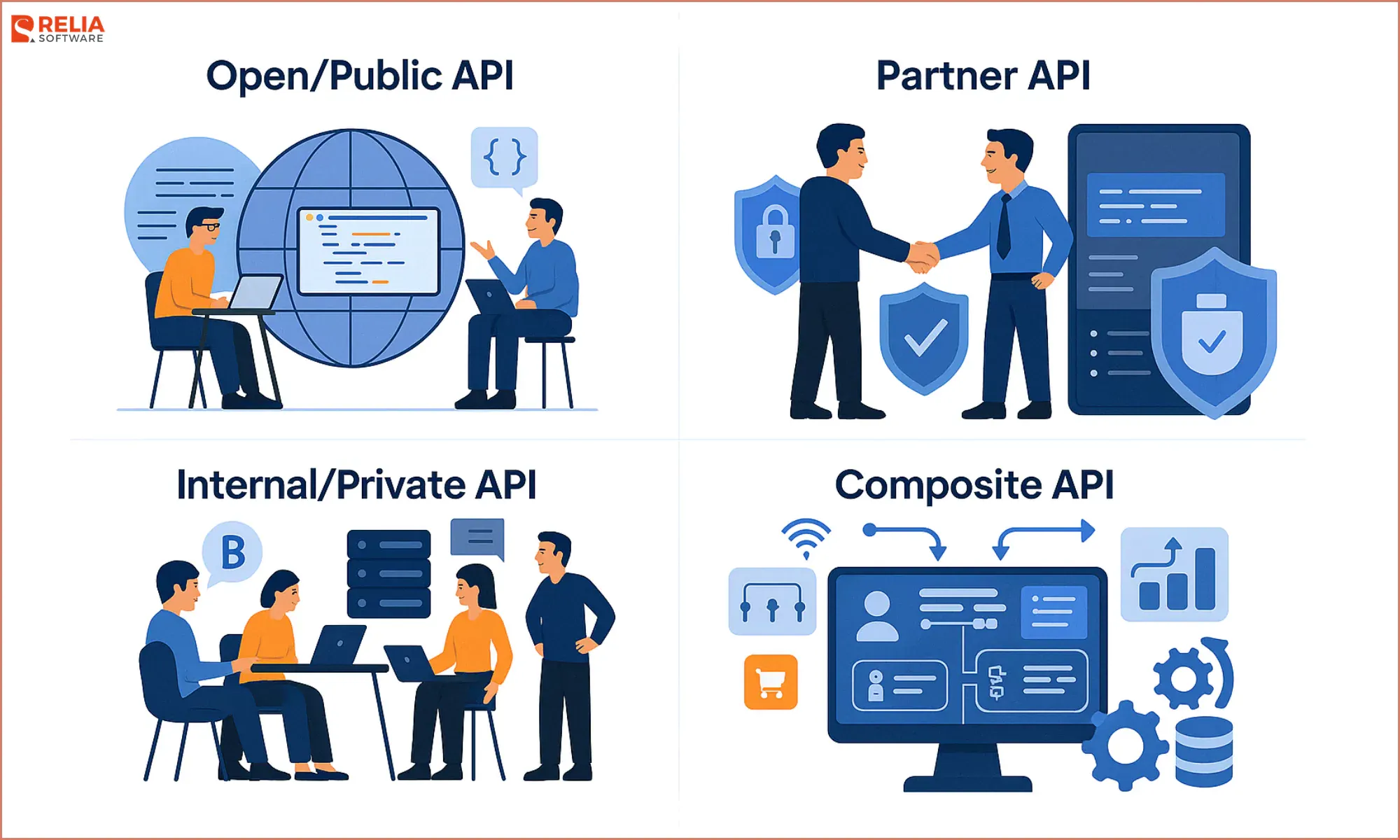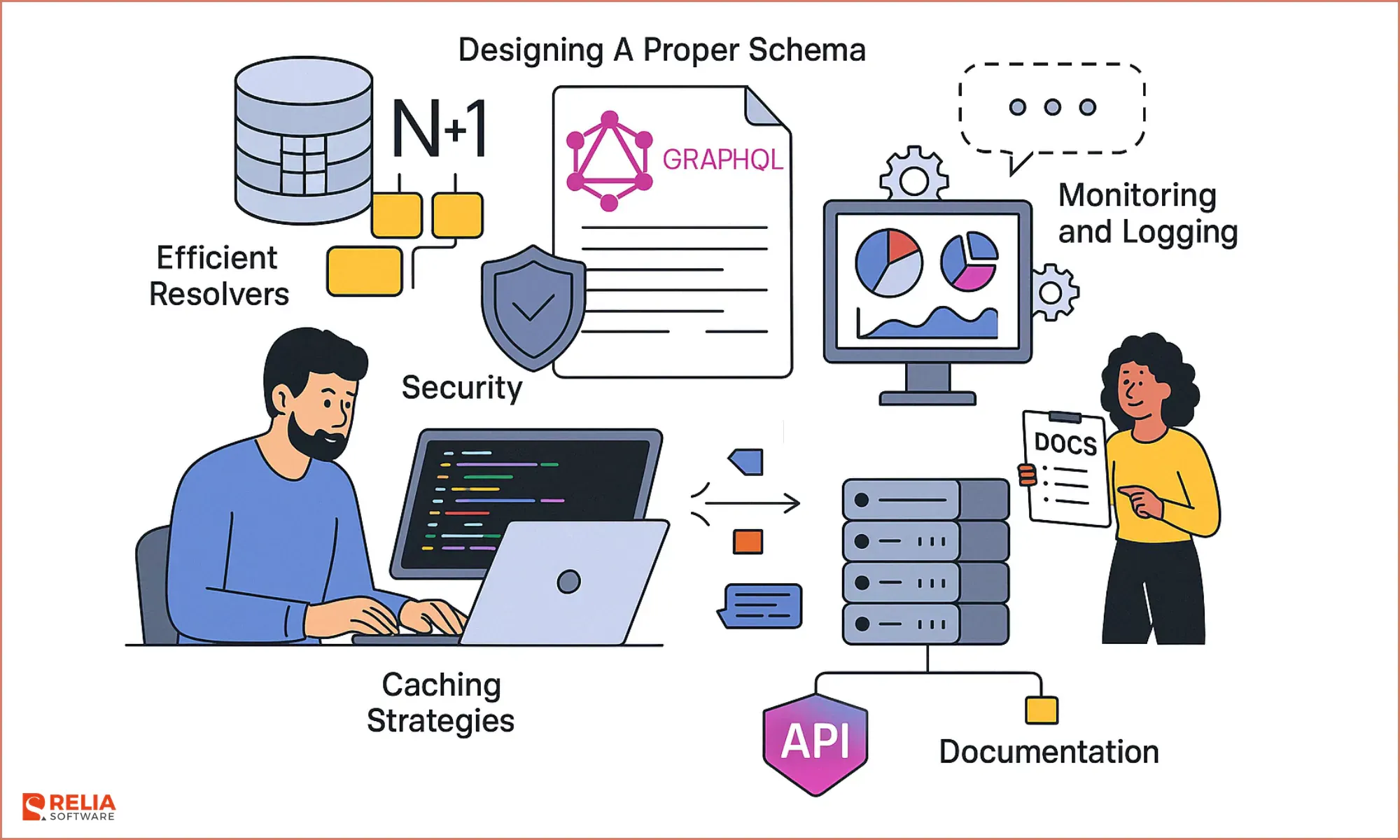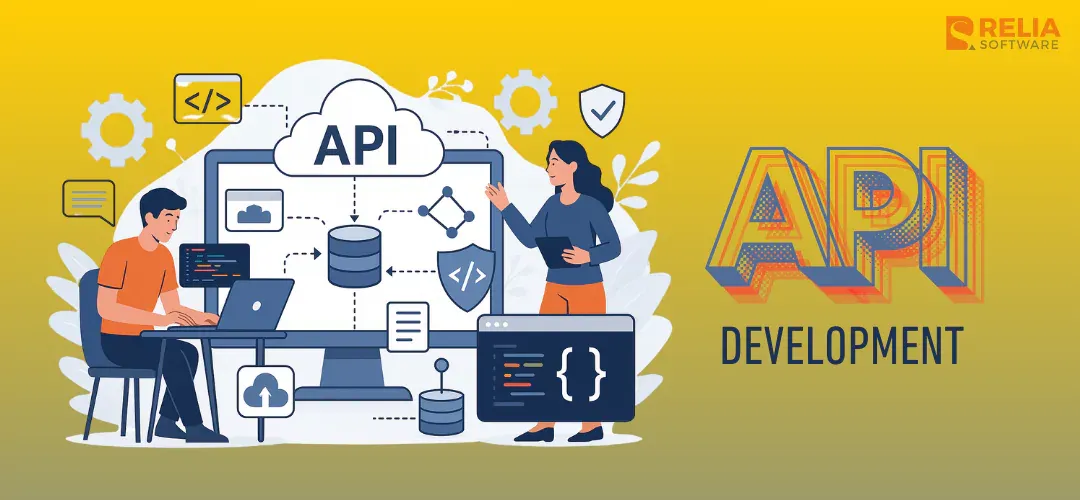Application Programming Interfaces (API) have become an integral part of modern Internet systems. The role of API has become so vastly integrated into the internet that a digital world without them seems improbable at this point.
There is a set process in developing an API that allows developers to access an API from one application and integrate it with their hardware or software. Designing an API requires proper programming instruction which makes it communicate with a different application. This article with discuss in depth, the foundation of API development and the key components it includes.
>> Read more: Gin-Gonic Tutorial: API Development in Go Using Gin Framework
What is An API?
An API is a piece of computer code containing a predefined set of instructions that enables a program to communicate with a different program and exchange information and data as requested by the user. However, this is not done in a human-understandable way as APIs mostly communicate in a set format like JSON. An API dictates how software components should interact with each other and is used to query, pull, and display information from one software to another.
An API can also be used when programming a graphical user interface (GUI) component, making it highly efficient in querying data as well as displaying results. There are also web-based APIs like REST-API or GraphQL. They create a channel for prompt information exchange between a web server/an application server and a phone/computer, allowing everyday users to get their requests processed in real-time.

>> Read more:
- What is tRPC? Building Robust APIs with TypeScript and tRPC
- gRPC vs GraphQL: Choosing the Right API Technology
How Does An API Work?
API architecture is commonly described as server and client. The client sends the request, and the server responds. For example, the weather agency's database is the server and the mobile app is the client.
APIs work in four distinct ways depending on their creation date and purpose.
- SOAP API: The Simple Object Access Protocol is utilised by these APIs. Through XML, the server and client communicate with one another. This API is older and less flexible.
- RPC API: "Remote Procedure Calls" describes these APIs. After a client completes a function (or procedure) on the server, the server will return the results to the client.
- Websocket API: JSON-based Websocket API is another modern web API. Two-way client-server communication is supported by WebSocket API. It's more efficient than a REST API because the server can deliver callback messages to connected clients.
- REST API: This is the most popular and flexible type of web API today. Servers receive client requests as data. Based on client input, the server starts internal functions and returns output data to the client.
The Importance of API in Modern Software Development
Enhanced User Experience
In the context of modern web and mobile applications, APIs play a significant role in querying and displaying data from the servers into the client device screens. With their dynamic ability to exchange information between programs, APIs are enhancing the overall user experience in terms of usability and functionality of modern applications.
Generated Revenues
APIs are also helping businesses generate revenues, integrate various systems, and collaborate to create new applications and software for the end user. For instance, a website or a mobile app that allows purchase and payment through VISA or ApplePay uses their API to safely send card details and credentials to the selected payment server from your phone.
Quick Integration of 2 Distinct Apps
The beauty of APIs lies in their ability to quickly integrate two completely different applications for the benefit of the user. Integration of Google Maps in ride-sharing apps is another example of this.
Because of Google Maps API, Uber, Lyft and other ride-sharing applications don’t have to come up with their own Maps for navigation, as integrating Google Map with their API is convenient.
>> Read more:
- Top 9 Modern Software Development Tools for Businesses
- Top 10 Best AI Development Tools for Software Developers
- Top 7+ No-code App Builders for Businesses in 2023
Architectural Considerations in API Development
There are various things that need to be considered while designing and developing an API. Choosing the right type of API, the tools it is designed with, the complexities it brings are things should be taken into account before starting with the API development.
These things will ensure that the API is robust, scalable, and secure and serves its purpose with its full potential. In API development, consider these factors:
Choosing the Right API Type for Your Project
Deciding on the right type of API for your project is the first and one of the most important steps in API development as it shapes how your services will be accessed by end users and other programs or developers.
APIs can be divided into different categories on the basis of their functionality like Open APIs, Partner APIs, Internal APIs, and Composite APIs. All of these differ in terms of security, scalability, and usage and they rely heavily on business needs and strategy.
Open/Public API
A Public/Open API is available to developers and businesses for access and implementation. The Open APIs provide elaborate documentation on their usage and implementation process. These APIs let businesses expand their presence and integrate with other apps and help students with their projects.
Partner API
Partner APIs are proprietary and strictly limited to usage between businesses or parties that have a collaboration between them. This means these APIs won’t be accessible to the third party. Partner APIs provide no publicly available documentation for understanding the functioning of the API. Partner APIs are mostly used by secure servers, financial institutions, and in supply chain management where security is a major concern.
Internal/Private API
The other type of API is an Internal or Private API which is more limited in terms of exposure. It is solely developed for a business and is used only inside the business to link services internally to improve communication and data exchange between internal systems.
For instance, payroll and HR records can be managed by an Internal API within an organisation to make salary and staff management more efficient. There are various other use cases of Internal APIs that are impacting the workflow in organizations in a positive way to increase efficiency. They allow businesses to increase productivity while keeping confidential and sensitive information secure.
Composite API
Composite APIs on the other hand allow developers to access more than one endpoint in one go. This is specially useful when a client needs access to various data in one query from a range of services. This is useful for businesses that need inventory management or client management or a combination of both.
For example, when a user signs up for an eCommerce website and orders something, a Composite API comes into action to facilitate things like User Account Creation, Cart Management, Checkout, and Inventory Management (Removing items from the stock and adding them to the user cart) as a whole.
In enterprise environments, especially, understanding the nuances between these API types is crucial.
- Internal APIs facilitate inter-service operability and can significantly enhance productivity.
- Partner APIs help maintain controlled ecosystems with external partners.
- Open APIs can extend your services' reach.
- Composite APIs can streamline interactions in complex system architectures.
Balancing these API types, considering the business context, security implications, and the desired level of accessibility, is fundamental to creating an effective API strategy.
These APIs are getting more powerful and complex with each passing day and are really improving the way we use IT systems around us. With their efficient workflow management and quick response time, APIs are the backbone of any functional IT system in 2025.

Leveraging GraphQL for Composite API Architecture
GraphQL has gained considerable popularity as a powerful alternative to REST APIs even since its release in 2015. While REST is the traditional API type for most web application based queries, GraphQL excels when it comes to composite API architecture with its complex data retrieval abilities and efficiency.
GraphQL provides efficient data loading and can also request multiple resources in one query, unlike REST which supplies one response to one query at a time. On top of that, GraphQL is clear and well-defined in terms of documentation and comes with real-time updates that make it easier to maintain consistency for large businesses in terms of server-side data.
There are several steps that are considered best practices while implementing GraphQL in APIs, some of them are:
Designing A Proper Schema:
Designing a well structured GraphQL schema helps reflect the relationship and highlight structure within the data. It also ensures that the API is intuitive and all the data and data relations are presented in an efficient way.
Efficient Resolvers:
Implementing resolvers within the API helps to avoid performance issues when multiple queries are made by the end-user asking for a particular data. For instance, resolvers help fix the N+1 problem, where multiple calls end up querying about the same or related data.
Caching Strategies:
Making use of efficient caching mechanisms to optimise response time and server load is important in implementing GraphQL. While caching can be quite difficult in GraphQL compared to REST API, there are tools that facilitate this process for API developers.
Security:
Protecting your application and the API against various security vulnerabilities and threats is always important. Measures like query depth limiting, complexity analysis help prevent DOS attacks and also ensure robust authentication and authorization.
Monitoring and Logging:
Setting up monitoring and logging systems to keep track of the usage and performance of the API is very useful which makes it easier to upgrade or enhance the functionality of your API by analysing usage pattern and error rates.
Documentation:
Documentation is the key to any software project if you want it to be understandable by other developers, clients and yourself. Providing comprehensive and detailed documentation makes sure your API can be used by everyone that it is designed for without hassle.

Best Practices for Effective API Development
A good API is efficient and effective in handling queries and giving results to the client. Designing an effective API is crucial for businesses as a lot relies on the data exchange and communication between applications and users in modern web and desktop applications. Sticking to the best practices in developing APIs makes sure your applications are working as you intend them to with increased efficiency and usability.
Essential Strategies for Robust API Development
There are some essential strategies that one can implement in developing an efficient API.
Firsly, the idea behind the use of the API should be clear when starting out with its development. If the intent is understood by the developer, they can then write codes to make it happen. Following RESTful principles is also key whenever its possible to implement. If using GraphQL, a well-structured schema is always important. Making use of API Design standards and security practices is also vital in coming up with an effective API design.
More importantly, thorough documentation is the key to a sustainable and efficient API. Having proper documentation makes it easier for other developers to understand and integrate your API in their systems.
Documentation should describe each and every functionality of the API in detail as a guide to anyone who may want to make use of it. This helps in onboarding of new developers into the project and also helps in maintenance as the information on the API will not be lost or seem confusing when there’s an issue that needs to be fixed.
Testing and Iterative development is also highly important when it comes to the effective API development and deployment. Rigorous testing with CI/CD systems helps in catching issues in the early stage of development and also makes sure any change in the future does not break the functionality of the API code.
An agile and iterative approach must be taken when designing and developing APIs, which includes taking feedback from stakeholders to continuously improve the function and usability of your API.
>> Read more: Top 12 API Testing Tools for Software Testing Process
Enhancing API Usability and Security
There are various ways that can be implemented to enhance the usability of the API while also making it more secure. This practice is essential for creating an efficient Application Programming Interface that everyone can trust and use. Poorly structured code and ill-documented APIs are something that will never be appreciated by developers or testers.
Error Codes Usage
Coming up with Error Codes are a great way to enhance the usability of the API code to begin with. Using HTTP status codes (eg 4xx for client errors and 5xx for server side issues), providing detailed error messages and logs, abuse detection and logging are something that make your API efficient and usable by many developers.
Format Consistency in API Structure
Consistency in the format of the API structure also plays a part as most people are used to working with a particular code base structure that is considered the norm in the software industry. Descriptive and Actionable error codes are reliable and understandable making the API integration a pain-free process for everyone involved.
API Gateways
API Gateways are something that is also responsible for increasing the usability and security of your API. The API gateway acts as the gatekeeper in the API world that facilitates secure data exchange and makes request handling efficient.
API Gateways route incoming requests to the concerned service and also provide a layer of security by implementing IP filtering, access control and authentication. They also perform protocol transformation, for instance, by opening a websocket from a HTTP request, between the user’s browser and the data server that allows two way communication between client and server. Gateways also distribute incoming traffic across backend servers to improve reliability of the application.
Practical Insights in API Development
APIs have virtually become the backbone of modern IT systems. They facilitate seamless communication and integration between various services and applications. Not only are they useful for IT houses and tech companies, APIs are used by virtually every business in the world today whether they designed it themselves or not. Most applications today work in sync with an API that silently carries out the data transition.
Web browsers, social media apps, eCommerce websites and restaurant recommendations are all possible and so functional today due to API integration. The future of API development looks even more promising as it is headed towards increased flexibility and functionality with each passing day.
The usage of GraphQL for data retrieval, AI for predictive analysis, and automated API management is improving API along with edge computing, reducing latency of application performance.
Design and Security
APIs became popular due to their efficiency and use. API design is so important in computer programming that developers now code the API before writing the software code that interacts with it. APIs are also integral in microservices architectures and allow various services to communicate with each other. This promotes scalability, flexibility, and faster development cycles of computer programs.
APIs are practical in the sense that they provide highly secure information exchange across platforms and applications. With various authentication and authorization protocols like OAuth, OpenID Connect, APIs ensure data encryption and security. These innovative features have helped APIs shape our modern technology-filled future in a better way.
Innovative Uses of APIs in Various Industries
Today, API is used in almost every industry in the world including education, software development, tourism and hospitality, healthcare, automobile, finance and even agriculture. While all businesses and individuals benefit from the rapid development in API integration, there are a few sectors that have benefited more than the rest. Here are 2 typical ones:
eCommerce: eCommerce makes use of APIs for the integration of services like CRM and Inventory management, making the shopping experience a thousand times easier. Payment gateways are another example of how eCommerce is booming with the help of APIs. They allow seamless and secure transactions between end-client, eCommerce platforms and banks.
Fintech: Fintech is another industry that significantly benefits from API development. With their assistance in payment processing, portfolio management, Regulatory compliance like KYC and automated data collection and verification, APIs make sure all banking transactions and records are safe and managed across various financial institutions. This has helped in making monetary transactions easier across the world.
Anticipating Future Developments in API Technologies
The future of API development looks bright as new tools and technologies make APIs more efficient every day. The innovation of Machine learning and AI also improve APIs. With the increase in demand for more integrated and secure applications, businesses will develop better APIs that enable service usage easier.
There are some emerging trends that we have already seen in API development like:
- The adoption of GraphQL in place of RESTful APIs.
- Machine Learning is being integrated into API development that will certainly improve the security, functionality and documentation of the APIs.
- Serverless computing and Edge computing are on the rise which puts APIs in a pivotal role in managing data between the endpoint and the server.
Real-time APIs will become popular soon with the increase in demand for real-time services which will mean WebSockets will be wide adapted around the internet. It can even be said that an ‘API First’ approach to software development will be considered by IT houses, especially in microservices architecture. This will mean developers will first design the API before coming up with the application that runs on top of it.
>> Read more:
- Roadmap To Become A Machine Learning Engineer
- Build and Handle Real-time Data with React, Node, WebSocket
- Understanding 6 Different Types of Indexes in SQL
Conclusion
To conclude, APIs are an intriguing field that has evolved and innovated quickly. This dynamic approach to software development and integration has been an integral part of all IT systems since they were first conceptualised. APIs save enterprises time, money, and resources by improving application and business efficiency.
API development has transcended its original concept and is now a subject of unlimited possibilities. Now, it is not just about linking software and databases, but more about linking businesses, people, data, and information worldwide. This evolution of API development showcases a wider realm of interconnected and user centred software and application solutions that transform our world in ways that we can only imagine.
>>> Follow and Contact Relia Software for more information!
- development
- Mobile App Development
- web development

